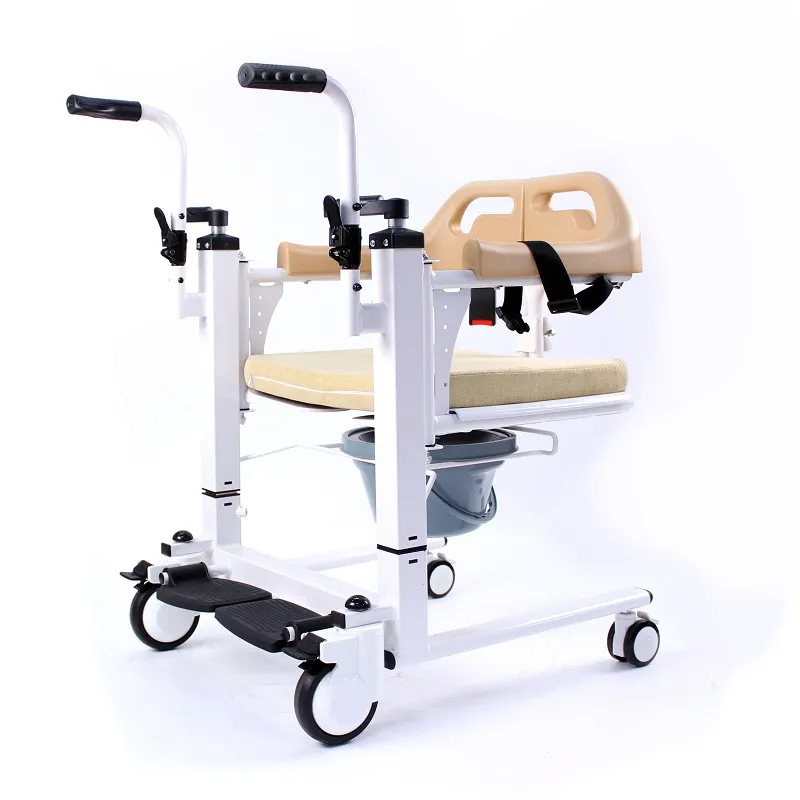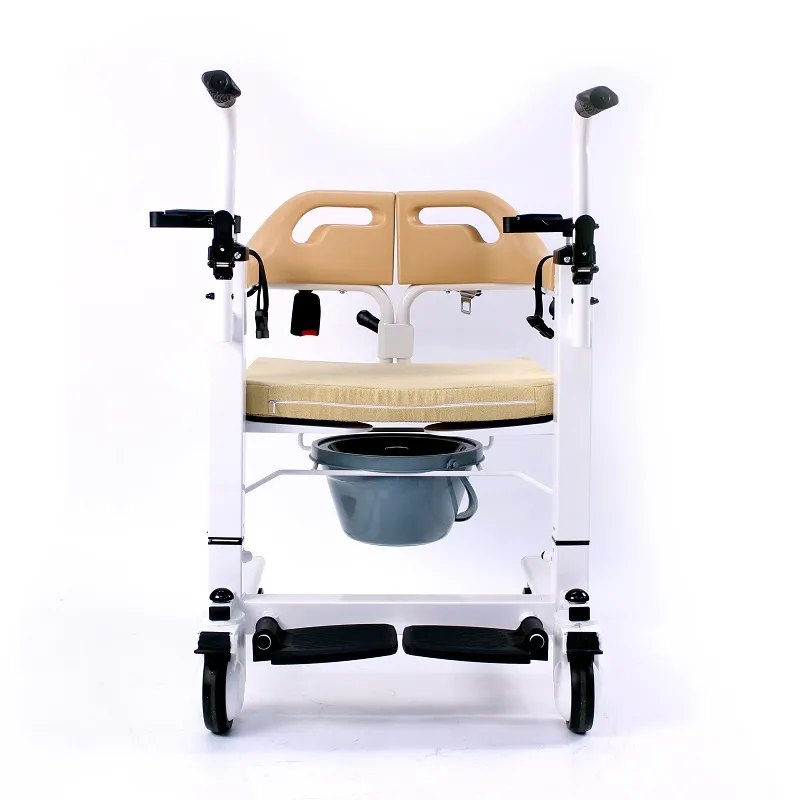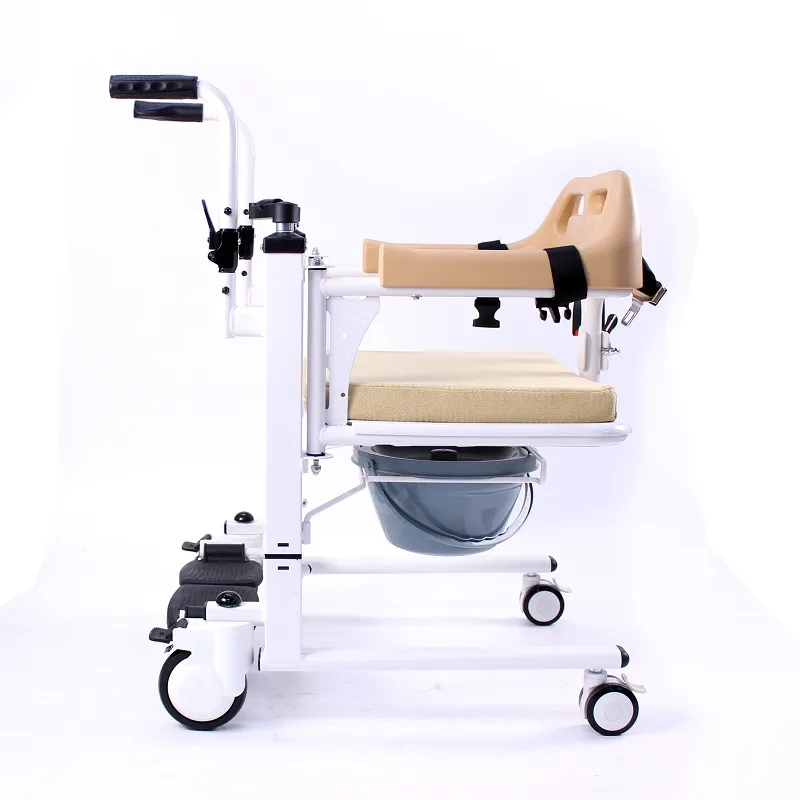A hydraulic lift transfer chair, a versatile nursing tool capable of lifting, moving, and toileting, is widely used in hospitals, rehabilitation centers, nursing homes, and home care settings. It uses a hydraulic system to adjust its height to accommodate varying heights of beds, toilets, and other equipment, ensuring smooth transfer and care for individuals with limited mobility.
However, many users report a common yet troubling issue: hydraulic lift transfer chairs experience a tendency to "slowly sink." Even without any input, the chair surface will occasionally or slowly slide downward, impacting nursing safety and the patient experience.
So, what are the reasons behind this phenomenon? Is it a design flaw, deteriorating materials, or improper use? This article will provide a comprehensive analysis to help users understand the root cause of hydraulic lift transfer chairs' constant sinking and offer solutions.
How Hydraulic Lift Transfer Chairs Work—Everything You Need to Understand
Before delving into the "why" of a hydraulic lift transfer chair, it's important to first understand its basic structure and operating principles.
1. Hydraulic System Configuration
The core component of a hydraulic lift transfer chair is its hydraulic pump system, which consists primarily of the following parts:
· Hydraulic cylinder: The power source for lifting and lowering motion;
· Piston and piston rod: Propelling the structure up and down under pressure;
· Hydraulic oil: The energy transfer medium;
· Check valve/relief valve: Controls oil flow and system pressure;
· Control device: Such as a foot pump or handle, controls oil injection and release.
The entire system operates based on Pascal's principle, which states that "fluid pressure within a closed container is uniformly transmitted." When the foot is on the hydraulic pump or the control lever is pushed, hydraulic oil is pressed into the hydraulic cylinder, pushing the piston upward. When the pressure is released, the piston descends, lowering the chair seat.

What are the symptoms of a hydraulic lift transfer chair that continues to sink?
Many users have reported that hydraulic lift transfer chairs may sink abnormally in the following scenarios:
1. The chair surface slowly descends when not in use;
2. It automatically descends after reaching the desired height for several minutes;
3. It descends faster when carrying a patient;
4. The chair surface has difficulty maintaining its highest position even when no one is seated.
This problem not only affects user efficiency but, more importantly, can lead to unstable patient posture, falls during movement, and increased caregiving risks, thus requiring significant attention.
Why does my hydraulic lift transfer chair keep sinking?
Five major causes of hydraulic lift transfer chair sinking:
1. Hydraulic oil leak
2. Failure of the check valve
3. The control handle is not properly closed
4. Piston rod wear/deformation
5. System load exceeds the designed load capacity
1. Hydraulic oil leak
Poor hydraulic system sealing is the most common cause of automatic sinking. Once the hydraulic cylinder, oil pipe, or seal is aged or cracked, hydraulic oil can slowly leak out, causing the piston to lose support and the chair surface to naturally sink.
· Identification: Visible oil stains on the chair frame or cylinder; failure to maintain height after applying the foot pump.
· Common Locations: Piston seals, oil pipe joints, and around the drain valve.
· Solution: Replace the seals or repair the oil pipes; in severe cases, the entire hydraulic cylinder may need to be replaced.
2. Failed Check Valve
Hydraulic systems typically have a check valve to control the flow of oil in only one direction, thereby maintaining the raised position. If the check valve is worn, the spring fails, or a foreign object becomes lodged, it can cause oil backflow, causing the chair to slowly lower.
· Technical Explanation: Pressure cannot be maintained, forcing hydraulic oil to flow back into the reservoir.
· Performance Impact: Lowering may be slow, but the chair will continue to lower.
· Repair Recommendation: Clean or replace the check valve components.
3. Loose Control Handle
The control device for a hydraulic lift transfer chair is typically a foot control lever or manual switch. If the control device is not fully reset or is not closed tightly, the hydraulic circuit may not be sealed.
· Identification: Forgetting to fully close the control lever after use.
· Symptom: The chair slowly lowers immediately after sitting.
· Solution: Check the operating procedures and replace the return spring if necessary.
4. Piston Rod Wear/Deformation
Over extended use, frequent lifting and lowering, excessive pressure, or misaligned operation can cause deformation or friction imbalance in the piston rod. This can make it difficult for the piston to provide stable support, preventing the lift position from locking.
· Technical Symptom: A sense of friction or resistance during lifting.
· Common Causes: Exceeding the load capacity or frequent and aggressive lifting.
· Suggested Action: Replace the piston assembly or calibrate the system.
5. System Load Exceeds Designed Load Capacity
Hydraulic lift transfer chairs are typically designed for a load capacity of 100–200 kg. Exceeding this range can overload the hydraulic system, causing it to sink. Even if there is no obvious component damage, insufficient oil pressure can prevent it from maintaining the raised position.
· Identification: Repeated sinking occurs with heavier users.
· Solution: Choose a reinforced or heavy-duty hydraulic transfer chair.

Hydraulic Lift Transfer Chair: "False Faults" Caused by Improper Use
In addition to system issues, some operating errors can also cause the hydraulic lift transfer chair to appear to sink:
1. Failure to reset the foot pump after use
Some equipment requires the control lever or foot pedal to be returned to the locked position after operation, otherwise the hydraulic oil passage remains open.
2. Excessive or rapid operation
Frequent, unrhythmic lifting and lowering can cause transient negative pressure in the system or allow air to mix into the oil, affecting support and causing "slippage" or "rebound sinking."
3. Unauthorized component modification
Replacing non-original cylinders or seals with non-original specifications may cause pressure leaks and exacerbate sinking.
Hydraulic Lift Transfer Chair Maintenance Recommendations and Usage Specifications
To extend the life of a hydraulic lift transfer chair and prevent persistent sinking, the following are professional recommendations:
Operation steps | Recommendations |
| Daily inspection | Check the hydraulic cylinder for leaks and smooth lifting and lowering monthly |
| Weight control | Strictly adhere to the equipment's load-bearing specifications (indicated in the manual) |
| Regular lubrication | Lubricate the piston and joints every three months |
| Operation within travel limits | Avoid stepping on or forcing the hydraulic system during lifting |
| Proper closing control | Check that the control handle is fully closed after each use |
| Regular maintenance | Have a professional inspect the hydraulic components annually for signs of wear |
Can the hydraulic system be repaired or replaced?
The hydraulic system of a hydraulic lift transfer chair is of "medium complexity" and cannot be disassembled and repaired by the average user. However, this does not necessarily mean that the entire unit must be replaced:
· Minor leaks or aging components: Contact the brand or technicians to replace the seals, oil pipes, or control valves.
· Hydraulic cylinder damage or poor oil return: Replace the entire hydraulic cylinder assembly is recommended.
· Severe structural damage or corrosion: Replace the entire unit.
Professional brands typically offer a 1–2 year warranty on the hydraulic system. Contacting the manufacturer's support is recommended first.

Using a Hydraulic Lift Transfer Chair Properly
As an essential aid for caring for critically ill patients, the elderly, or those undergoing surgery, the stability and reliability of a hydraulic lift transfer chair are crucial. "Continuous sinking" is not a sign of poor quality, but rather a manifestation of multiple factors, including aging of the hydraulic structure, valve failure, overload, or seal failure.
The key to resolving this issue lies in:
1. Comprehensively identify the cause: Investigate each issue, from the hydraulic system to the operating method;
2. Use the equipment appropriately: Follow the instructions in the manual and avoid any unauthorized operation;
3. Perform timely maintenance: Have the hydraulic system regularly serviced by professionals;
4. Select the model based on your needs: Choose the appropriate product based on your weight and frequency of use.
Why is Dayang Medical considered a high-tech enterprise?
Dayang Medical is recognized as a National High-Tech Enterprise in China because of our continuous innovation and patented technologies. We invest heavily in R&D, particularly in electric products and high-end wheelchair design. Buyers benefit from advanced, customized, and reliable medical devices at competitive factory prices.
Our factory supplies wholesale orders worldwide, offering discounts and promotions for bulk purchases. Whether you are purchasing wheelchairs, hospital beds, or walking aids, Dayang Medical combines innovation with affordability.










